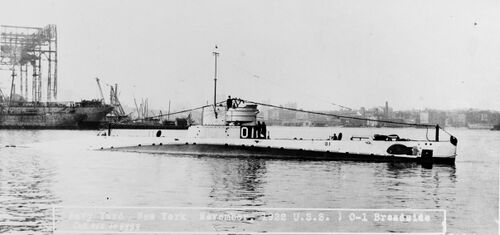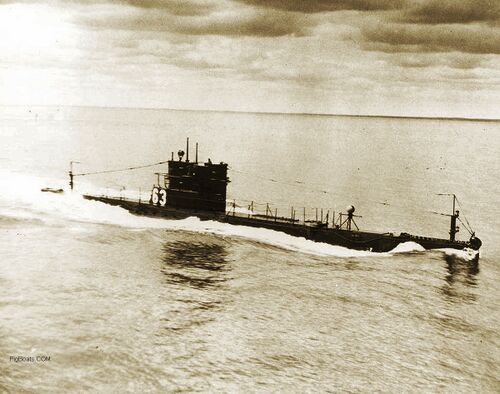O-class: Difference between revisions
Pbcjohnston (talk | contribs) mNo edit summary |
Pbcjohnston (talk | contribs) (Added photos) |
||
| Line 13: | Line 13: | ||
=== <big>O-1 (SS-62)</big> === | === <big>O-1 (SS-62)</big> === | ||
<div style="text-align: justify;"><span style="color:#00008B"> | [[File:O-1 stbd.jpeg|left|500px|Photo NH 44543 courtesy of NHHC.]] | ||
<div style="text-align: justify;"><span style="color:#00008B">O-1 underway off the Brooklyn Navy Yard, New York City, November 1922. There is one sailor half way out of the torpedo room hatch.</span> | |||
[[O-1|See more O-1 photos]] | [[O-1|See more O-1 photos]] | ||
| Line 20: | Line 21: | ||
=== <big>O-2 (SS-63)</big> === | === <big>O-2 (SS-63)</big> === | ||
<div style="text-align: justify;"><span style="color:#00008B"> | [[File:O-2 on surface.jpg|left|500px|USN photo]] | ||
<div style="text-align: justify;"><span style="color:#00008B">O-2 running on the surface during WWII, November 26, 1943. The location is in the western Atlantic off the coast of Long Island, NY. By this time the original 3"/23 caliber Mk 9 gun had been removed. These boats were used to train basic course students at the Submarine School in Groton, CT. so it was felt that the gun was not needed. O-2 has received the mandated safety modifications, with McCann Chamber compatible hatches forward and aft, rescue/marker buoys, and a motor room escape hatch. The unusual structure on her forward deck that looks like a stick figure is actually the transducers for the JK/SC sonar array.</span> | |||
[[O-2|See more O-2 photos]] | [[O-2|See more O-2 photos]] | ||
Revision as of 12:28, 2 October 2023
Design, Construction, and Naming Notes
USS O-5 (SS-66) was sunk in a collision with a steamer near the entrance to the Panama Canal. Three men died, 16 successfully escaped before the boat went down, and two, Henry Breault and Lawrence Brown were trapped alive in the torpedo room. The bow was lifted from the mud and the two men were rescued. O-5 was a total loss and even though she was salvaged the boat was not returned to service. She was sold as scrap in Balboa, C.Z.,Panama.
These were the first U.S. submarines with really satisfactory diesel engines from the start. In addition, they were the last USN submarines built with 18-inch torpedo tubes. All subsequent USN designs used 21-inch diameter tubes. In general they were well liked and quite useful, although once again the Lake variant was rated inferior to the EB boats. They spent a lot of time in Panama guarding the approaches to the canal. The Lake boats were discarded in the mid 1920's, and the EB boats were laid up in mothballs In Philadelphia between 1931 and 1941. They were hurriedly returned to service as war clouds loomed in 1941 and served in a useful capacity as training boats in New London. Unfortunately, USS O-9 (SS-70) was lost with all hands in a tragic accident in June 1941. Her crew is "On Eternal Patrol".
The decommissioned O-12 was pulled out of mothballs and sold back to Lake. He had the boat heavily modified for Sir Hubert Wilkins' polar expedition of 1930 and renamed it Nautilus. It was intended to run the boat under the ice all the way to the Pole. It was not successful in this role and it sank in a deep Norwegian fjord in 1931.O-1 (SS-62)

O-2 (SS-63)

O-3 (SS-64)
O-4 (SS-65)
O-5 (SS-66)
O-6 (SS-67)
O-7 (SS-68)
O-8 (SS-69)
O-9 (SS-70)
O-10 (SS-71)
O-11 (SS-72)
O-12 (SS-73)
O-13 (SS-74)
O-14 (SS-75)
O-15 (SS-76)
O-16 (SS-77)
General O-class Photos
See more General O-class photos
Page created by:
Ric Hedman & David Johnston
1999 - 2023 - PigBoats.COM©
Mountlake Terrace, WA, Norfolk, VA
webmaster at pigboats dot com
